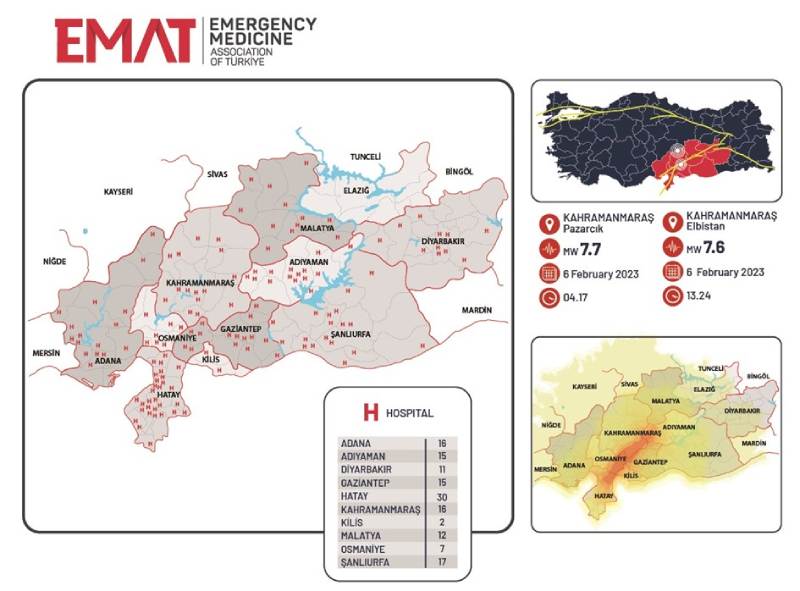
Issues Identified by an Immediate Frontline Assessment Team for the 2023 Türkiye Earthquake
Serkan Yilmaz M.D. Prof FEMAT
Prof. Serkan Yilmaz, MD 1, Ibrahim Ulas Ozturan, MD 2, Mustafa Sabak, MD 3, Prof. Cem Oktay, MD4
1 President of the Emergency Medicine Association of Turkiye. Kocaeli University, Faculty of Medicine, Dept. of Emergency Medicine
2 ACEP International Section Ambassador Program, Liaison for Turkiye. Kocaeli University, Faculty of Medicine, Dept. of Emergency Medicine
3 ACEP International Section Ambassador Program, Liaison for Turkiye. Gaziantep University, Faculty of Medicine, Dept. of Emergency Medicine
4 ACEP International Section Ambassador Program, Liaison for Turkiye. Akdeniz University, Faculty of Medicine, Dept. of Emergency Medicine
Background
On February 6, 2023, at 04:17, a seismic event with a magnitude of 7.7 Mw on the moment magnitude scale occurred in the southeastern region of Turkey. A secondary earthquake, registering a magnitude of 7.6 on the moment magnitude scale, occurred nine hours after the initial event, resulting in significant damage and loss of life.1
In response to the earthquake, the Türkiye Disaster Management Plan (TDMP) was implemented, incorporating the efforts of public institutions, the private sector, and non-governmental organizations. The TDMP system employs an integrated planning approach and a modular structure designed to manage operational risks effectively in a disaster scenario. The TDMP framework comprises various essential elements such as proficient planning, a versatile and expandable structure, ongoing enhancement and innovation, coordination, teamwork, harmony, information management and communication, and compliance with relevant regulations.2
Despite the swift response from the public sector following the earthquakes on February 6, 2023, obstacles emerged in both vertical and horizontal dimensions of disaster relief operations. During the initial week, managing the health response posed significant challenges due to logistical, personnel distribution, communication, and treatment-related concerns. The Emergency Medicine Association of Türkiye issued an article aimed at guiding emergency physician responders on managing mega-disasters. The article addresses challenges associated with such events.3
The acute intervention phase, which prioritizes promptly addressing the patient's immediate needs, is fundamental in disaster management. The current conditions confirm the area's designation as a disaster zone. Gaining a comprehensive understanding of the TDMP's acute disaster response necessitates the assessment of earthquake characteristics. The effectiveness of the acute intervention phase depends on the seismic intensity and the distinctive characteristics of the affected area. The seismic event affected the following regions: Kahramanmaraş, Hatay, Gaziantep, Osmaniye, Malatya, Adana, Diyarbakır, Şanlıurfa, Adıyaman, and Kilis. Spanning 500 kilometers, the earthquake impacted 13.5 million individuals, including 2 million Syrian refugees.3
The timing of the seismic event and adverse weather conditions presented formidable obstacles to the progress of emergency response personnel. Regional and nationwide aid groups faced complications in their response efforts due to intense snowfall during the coldest part of the winter season. Post-earthquake tremors and harsh winter weather affected the region's roads. The airports serving civilian traffic in Malatya, Antep, and Kahramanmaraş closed following the earthquake. Due to the earthquake's effects on the runway, Hatay Airport suspended flight operations. Consequently, a substantial volume of relief supplies and personnel had to be transported to the region via the highway. The rapid hiring of skilled personnel emerged as the primary challenge during the earthquakes. This factor is historically significant within the framework of disaster response operations in Turkey.
Regional Healthcare Facilities and their Corresponding Reactions
An examination of regional healthcare facilities and their corresponding responses is necessary. Global seismic activity resulted in a Stage III Potential Injury Event (PICE) that inflicted considerable damage to the infrastructure, including the healthcare system.4 The damage to the local service area infrastructure and the strain experienced by rescuers and medical personnel due to the disaster hindered the effectiveness of the local response.
Hospitals in Kahramanmaraş and Hatay underwent evacuation procedures. Injured patients were admitted to hospitals in Adana and Mersin. The adverse impact on hospitals, staff morale decline, and material losses interrupted patient care, despite the urgent need for healthcare services. Patients received medical care at emergency departments situated on the first floor of the hospitals, where the structural damage was minimal. The delay in establishing alternative care sites was attributed to a failure to activate hospital disaster plans. The disaster significantly affected all emergency responders in the area, leading to a decrease in their effectiveness. (Figure 1)
The Rrovision of Medical Treatment and Patient Care Delivery
Healthcare facilities in the impacted region formulated patient treatment plans based on transfers since hospital structures were inaccessible in the aftermath of the disaster. Three days post-disaster, a significant number of healthcare personnel deployed to the affected region reported limited experience and familiarity in handling patients impacted by the catastrophe. In the initial phases of the disaster, hospitalizations accounted for a significant percentage of mortalities. An increase in the number of deceased patients brought to emergency rooms by relatives in affected regions necessitated the establishment of a strict triage protocol. Initially, a significant percentage of medical practitioners working in emergency departments were affected by the disaster. Healthcare professionals who conducted triage protocols during the catastrophe encountered difficulties in categorizing patients who were triaged as black. A diverse group of healthcare professionals assisted in the disaster area. Emergency physicians played a crucial role in organizing and prioritizing patient care, while surgeons performed amputations and fasciotomies. Internists managed dialysis and addressed complications arising from patients who were unable to take their chronic medications due to the disaster. According to a consensus among emergency physicians, one noteworthy observation in the field of earthquakes relates to the advantages of assuming the Fetal Position within the Triangle of Life compared to the Drop, Cover, and Hold On method. These advantages include a reduction in surface area, a decrease in the occurrence of crush injuries, protection of larger body parts from harm, enhanced protection against hypothermia, and improved maintenance of basal metabolism.5
Incomplete diagnoses during the initial evaluation have been identified as a primary cause of emergency admissions for disaster victims within the first 72 hours following the event. This can result in incomplete treatment during the early stages of the disaster. Some individuals suffered from carbon monoxide poisoning due to using coal and wood for heating within tents or while attempting to stay warm near a campfire. Empirical evidence indicates that some emergency departments may lack the necessary resources to conduct bedside imaging. As a result, it may be necessary to transfer patients to the radiology department within the hospital for imaging procedures. This resulted in a staff shortage for hospital transportation duties and a limited supply of stretchers. Emergency departments equipped with ultrasound devices demonstrated improved proficiency in managing these procedures. The use of bedside ultrasound expedited the diagnostic process.
Türkiye National Disaster Response System
The National Disaster Response System is responsible for facilitating a country's preparedness and response efforts during disasters. Regional earthquakes have occurred in Van, Elazig, and Izmir since 1999. The TDMP was tested during these events. Seismic events of moderate magnitude necessitated the implementation of disaster management protocols in certain regions. These seismic events were the primary means of assessing the overall functionality of the system. On February 6, 2023, a seismic event of significant magnitude served as a comprehensive test of the nation's disaster preparedness and response infrastructure. An evaluation of the national disaster was conducted to develop strategies and plans aimed at enhancing future preparedness measures. Organizations with dedicated emergency response personnel follow established protocols to gather information and transmit it to the appropriate emergency response channels. During this catastrophic event, the emergency response center faced challenges in consolidating data from various government departments.
The seismic event caused a disruption in communication channels, impeding the assessment of its impact across the country. Inconsistencies between field data on the extent of damage and requests for assistance hindered the effectiveness of response efforts. When addressing damage, adhering to a designated protocol is crucial. It is imperative to assess pertinent details on a case-by-case basis while responding to a request for aid. Insufficient information has resulted in a knowledge gap between field personnel and logistics support staff. Despite the establishment of predetermined backup regions and relief agencies for each province, the devastation in the designated aid provinces impeded the effectiveness of the emergency response strategy. Consequently, the protocol was deemed impractical. However, this established methodology cannot replace alternative approaches. Logistical assistance providers were unable to establish a comprehensive system to effectively manage the extensive ramifications.
Despite the demanding work environment, a plethora of healthcare practitioners promptly addressed emergency situations. Hospitals affected by the initial earthquake received significant assistance from emergency medicine specialists. The inability to implement efficient triage in the field and at hospitals resulted in an overwhelming influx of patients with heightened acuity levels, rendering the situation unmanageable. Due to hospitals reaching their maximum capacity, personnel from security, transportation, and custodial departments were enlisted to assist in patient triage at different healthcare facilities. The seismic event caused operational disruptions for several emergency response agencies. Consequently, the quality of healthcare delivered to patients was compromised. The lack of activation and coordination of local disaster plans for hospitals can stem from various factors, such as disaster readiness, damage to hospital infrastructure, insufficient resource reserves, and mobilization of disaster victims.
Discussion
This article aims to identify the primary challenges encountered during the response to the earthquakes that occurred in southeastern Turkey in February 2023 and to provide suitable remedies.
Typically, operational plans incorporate the premise that assistance will be extended following a formal request. This process involves managing significant amounts of data. Delays in implementing collective action can occur due to decisions made by national-level decision-makers. Under such circumstances, professionals at the regional level must utilize alternative decision-making methods. It is crucial to possess both authority and capability. Successful disaster response requires cooperation between governmental and administrative organizations. The decision-making processes related to resource allocation need improvement. Creating a contingency plan to address unforeseen circumstances and implementing well-defined procedures and protocols for organizational modifications are advisable.6 It is recommended that relevant organizations authorize decision-makers and emergency responders to modify the current strategy.
It is essential to prioritize the implementation of telemedicine programs in disaster-prone regions. Telemedicine networks have the capability to effectively manage chaotic post-disaster scenarios and their potential recurrence. Healthcare facilities located in disaster-prone areas should implement alternative registration methods that consider the possibility of digital infrastructure failure. There is a compelling need for scholarly investigation into disasters, with the aim of analyzing regional disaster data and enhancing preparedness for future disasters.
Data obtained from emergency physicians in the disaster zone indicate that the current disaster response system is proficient in managing minor and moderate disasters; however, it struggles with intricate mega-scale disasters on both national and global scales. Under such circumstances, executing intervention strategies in a timely and systematic manner is imperative. Ensuring accurate information transfer and maintaining a modern organizational network resistant to technological disruptions can improve intervention effectiveness.
Disaster victims often must manage their situations independently. According to global disaster data, certain impacted regions are not readily accessible to search and rescue teams. The existence of urban emergency departments, meticulous planning for out-of-hospital scenarios, prompt implementation of acute medical interventions, and adherence to contemporary public health principles are essential for effective disaster management. Metropolitan areas are required to attain self-sufficiency within a 72-hour window following a catastrophic incident.7
Conclusion
The efficacy of Türkiye’s disaster management system was deemed inadequate during the earthquake. The current system effectively and efficiently manages small-scale and manageable disasters. In situations involving significant disasters that require organizational responses, reliance exclusively on disaster response plans and action guides may be insufficient. Our current priority is to collaborate with relevant entities to develop a response and recovery strategy that can effectively address the numerous challenges posed by a catastrophic event.
Figure Legends
Figure1: Healthcare facilites in the earthquake zone
References:
- AFAD, 2023. 06 Şubat 2023 Pazarcık-Elbistan (Kahramanmaraş) Mw: 7.7 – Mw: 7.6 Depremleri Raporu. 140 s. Available at: https://deprem.afad.gov.tr/earthquake-reports
- Ulusal Afet Müdahale Planı Available at: https://www.afad.gov.tr/kurumlar/afad.gov.tr/2419/files/afet_mud_pl_resmig_20122013.pdf
- Türkiye Acil Tıp Deneği Kahramanmaraş Merkezli Depremler Acil Tıp Uzmanları Saha Gözlem Raporu. Available at: https://tatd.org.tr/wp-content/uploads/2023/02/2386ba4ace1f5b53491d0d62eb432dfb.pdf
- Kristi L. Koenig et al. Disaster Nomenclature–A Functional Impact Approach: The PICE System. Acad Emerg Med. 1996 Jul;3(7):723-7. doi: 10.1111/j.1553-2712.1996.tb03498.x.
- Mustafa Ferudun Celikmen, Sarper Yilmaz, Ali Cankut Tatliparmak, Figen Unal Colak. Drop, Cover, and Hold On versus Fetal Position in the Triangle of Life to Survive in an Earthquake: A Delphi Study. Prehospital and Disaster Medicine , Volume 38 , Issue 3 , June 2023 , pp. 287 – 293 DOI: https://doi.org/10.1017/S1049023X23000444
- A multi-disciplinary view on earthquake science. Nat Commun. 2022;13(1):7331. Published 2022 Dec 9. doi:10.1038/s41467-022-34955-6
- WHO. Turkey earthquake: health infrastructure intact, WHO supporting emergency response Accesed from: https://www.who.int/europe/news-room/photo-stories/item/turkey-earthquake-health-infrastructure-intact-who-supporting-emergency-response. Accesed date: 07.03.2023



